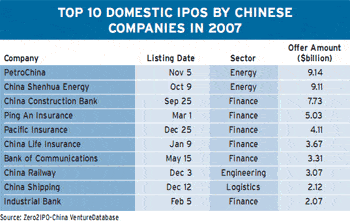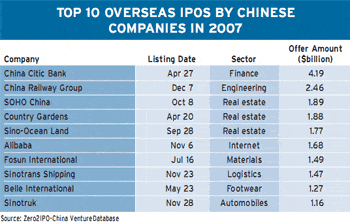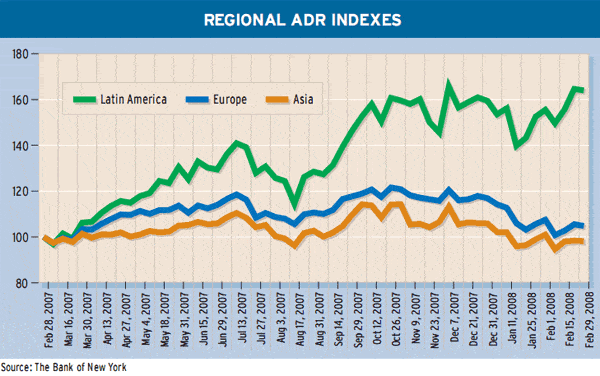
China Railway Construction raised $5.4 billion in March via a dual-track offering in Shanghai and Hong Kong that was the largest IPO in Asia so far this year. Citi, Macquarie Capital and Citic Securities handled the sale.

Ping An Wins Approval
China National Offshore Oil, China’s largest offshore oil producer, and China Mobile Communications, the largest telephone company in the country, are also likely to float shares this year. These “red chip” companies, incorporated overseas and traded in Hong Kong although their businesses are on the mainland, are expected to raise domestic funds and to be listed on the Shanghai Stock Exchange.
Edmond Chan, Hong Kong-based partner of PwC Capital Market Services, says red chips are likely to start listing on the mainland market in the second half of this year. “Although the world is still overshadowed by subprime concerns that upset markets in recent months, the mainland stock market will flourish due to its excess liquidity and strong economy, helped by domestic demand,” he says.
Of the upcoming IPOs in China this year, PwC expects 35 to be launched on the Shanghai Stock Exchange, with the remaining 100 offerings likely to be listed on Shenzhen’s Small and Medium Enterprises Board.
Companies raised more money through stock offerings in China last year than in the previous six years combined, as the government encouraged state-owned firms listed in Hong Kong to tap the mainland market. Most major H-share companies, which are incorporated on the mainland and listed in Hong Kong, have already established a secondary listing on the domestic market, known as the A-share market.
“If the Hong Kong-listed red chips are granted a green light for their A-share issues in 2008, the total IPO funds raised in the Shanghai and Shenzhen capital markets are expected to reach 480 billion yuan [$67 billion],” says Frank Lyn, leader of China markets at PwC. “We believe the Chinese capital market will continue to grow in a stable and healthy way,” he adds.
Big First-Day Gains
In 2007 share prices of all Shanghai and Shenzhen newly listed issues achieved outstanding gains in their debuts, with 98% of them recording increases of more than 50% from their offering prices on the first trading day. Alibaba.com, China’s biggest e-commerce company, had the biggest first-day price rise of any Chinese IPO last year, as its shares nearly tripled in value. The China Securities Regulatory Commission, the main market regulator, has the final say on how IPOs are priced and prefers lower prices to make sure that issues are successfully sold. Meanwhile, IPO mania also is stirred by the fact that Chinese investors have few other places to invest due to curbs on overseas stock purchases.
Infrastructure Play

Overseas Projects
China Railway Construction plans to spend 90% of the proceeds it receives from the IPO to purchase equipment for use in overseas projects. It said in its listing document that it expects revenue from its overseas construction projects to increase in coming years and to constitute a larger part of its total revenue from construction projects. The company won a total of $12.5 billion of overseas construction contracts last year.
In the past decade China has become the fastest-growing investor in African infrastructure as part of a strategic effort to secure mineral and oil resources and develop future markets. Last year China’s largest bank, the Industrial and Commercial Bank of China, acquired 20% of South Africa-based Standard Bank for $5.5 billion, another sign of the growing ties between China and Africa.
China Railway Construction was only the second company to conduct simultaneous offerings in Shanghai and Hong Kong after China Railway Group in December 2007. China Railway Group’s Hong Kong shares have increased about 62% in value since then, while its Shanghai-listed shares have more than doubled in price. The company sold $3 billion of shares in Shanghai and another $2.5 billion in Hong Kong.
Snow Disaster Cited
A total of $42 billion will be invested in China’s railway construction this year, and foreign investment in the construction of railways will be introduced at a proper time, China’s railway minister Liu Zhijun said last month. Millions of passengers were stranded in January when the worst snow disaster in 50 years cut power to electricity-powered train engines on the key Beijing-Guangzhou railway and other major lines.
“The snow disaster exposed a laggard railway situation, far behind the country’s economic and social development,” Liu said. He urged local railways to maintain a balance between trains with electrified and gas-fueled engines.
The minister said many railway projects would be opened to foreign investors, including the $21 billion Beijing-Shanghai high-speed railway, the most expensive engineering project in China’s history. Designed for trains operating at 186 miles per hour, the new high-speed line will reduce the journey time between Beijing and Shanghai from 14 hours to just five hours.
China had hoped to complete the line by 2010, but construction is now expected to take until at least 2015. An estimated 220,000 passengers will use the line daily. Alstom of France and Siemens of Germany, along with Japan-based Mitsubishi-Kawasaki, are expected to bid for parts of the project.
US Exchange Listings
Issuers from China were responsible for two-thirds of new US stock exchange listings of depositary receipts in 2007, according to the Bank of New York Mellon’s annual report on the DR industry. Significant IPOs in DR form included China-based Xinhua Finance Media, JA Solar, Simcere Pharmaceutical, Agria and Noah Education. The year’s most actively traded DR was China-based Baidu.com, which was the first DR ever to trade more than $200 billion in one year. China Mobile and PetroChina also were among the most actively traded DRs last year.
The total value of US investment in non-US equities, both DRs and non-US shares, increased 29% from a year earlier to $4.9 trillion as of September 30, according to the latest US Federal Reserve statistics.
The persistent decline in the dollar for the past six years has been a boon for dollar-based investors in global equities, says Binky Chadha, strategist at Deutsche Bank Securities, based in New York. The dollar’s depreciation added on average 5.8% in performance to the typical global portfolio annually from 2002 to 2007. This accounted for 60% of the better performance of international equity portfolios relative to US equities since 2002 and 80% of the excess return during 2007.
Is It Time to Hedge?
“Should the dollar reverse course, the resulting drag on overseas holdings by US investors could be significant,” Chadha says. Over the past six years the dollar has fallen 37% against the major currencies, suggesting that the current downward cycle is mature, he says. Since the introduction of floating exchange rates, the average magnitude of long-term downward cycles in the dollar has been 40%.
Meanwhile, the US current account deficit as a share of gross domestic product peaked in the fourth quarter of 2005 and has been shrinking since, Chadha says. “US net capital inflows have fallen off sharply since the financial crisis last summer, but we expect they will recover with the US economy in the second half of 2008,” he predicts. “The stars may be aligning for a sustained turn in the dollar as 2008 progresses,” he suggests. He adds that the time may be right for international equity investors to think about hedging their foreign exchange exposure.

Gordon Platt



